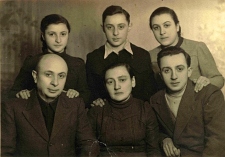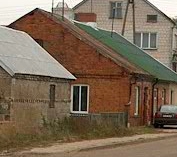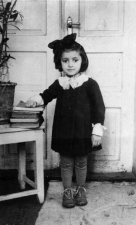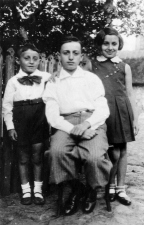Testimony of Chaya (nee Wasersztejn) Finkielsztejn:
|
|
|
|

|
|
Finkielsztejn Family
Upon arrival in Israel, 1946
[Bottom row L-R]: Yisrael Finkielsztejn, wife Chaya (nee
Wasersztejn) Finkielsztejn and eldest son Menachem
[Top row L-R]: Chana, Sholem, Yaffa
Entire family of six survived the Holocaust
Went to Israel, 1946 |
|
| |
|
Testimony of Mrs. Chaya Finkielsztejn concerning her experiences during the Shoah in the
town of Radzilow, and in hiding with farmers along with her husband and four children.
I was born at the beginning of the year 1897 in the town of
Radzilow. My father was Menachem Wasersztejn; my mother was Sheyna (Yaffa) of the family
Grajewski. I had seven brothers. Their names: Yaakov Berl, Yosef, Shayeh
Mordechai, Kalman, Chaim Leib, and two brothers who died as young children. The fate of the five
brothers: one perished in Szczuczyn, tortured by the Poles, three were burned alive in
Radzilow, and one brother at that time was in America.
I was married in the year 1920.
Question: Where were you educated?
-- I was self-educated. In my town I had no opportunity to
study with teachers. Only once a year, for a month, I had a teacher, during vacation time.
In this fashion, I learned Hebrew, Polish, and Russian. But I did not reach any goal with
my education.
Question: Which organizations did you belong to?
-- We organized in our town in1917, after the Balfour
Declaration, a Bnei-Tziyon organization. We were among the founders. In our town we
organized Zionist culture. The population was a poor one. We would have performances and
with the money we brought in we created a library of 500 books. Fifty percent went for
Keren Kayemet, and fifty percent for cultural work.
We opened a reading hall, which had all the Jewish-Zionist
literature-newspapers and journals, such as "Hatzefirah," and other Jewish
newspapers, which were current among Jews.
Thus it was until the Poles came to power, until the year
1918. When the Polish military entered our town there was a pogrom. The then proud Jews
avoided it. They approached the Christians and said, "We will go into the fire
together. As soon as you allow a pogrom, the entire city will go up in fire." One of
my brothers was among this group.
The best of the respected members of the community, those
in charge, came out and drove away the hooligans (many villagers had already come
running). The pogrom was avoided.
In the morning the Polish military entered. The hooligans
did what they wanted to do. They destroyed the library, tore up the books. Later, we found
some of the books.
At that time, the youth had scattered. Later, we founded
the "Hechalutz" and carried on with our work. At that time, there was no
official Zionist organization except for Keren Kayemet, Keren Hayesod, and chalutzic
organizations, such as "Hechalutz Haboger" and "Hechalutz Hatzair."
At that time a communist organization also functioned in
our town, the "Peretz Library." We did not want the youth to go the communist
way. My husband was the chairman of "Hechalutz" and the representative to the
Polish regime all the years until the war. He was the responsible person. Almost all the
youth were in "Perachim" and in "Hechalutz." Of those who were older,
some were already with the communists in the "Peretz Library."
Question: Can you name some who were the workers at that
time?
-- I can. In the last years they were: Moshe
Bursztyn, Wolf Szlapak, Rozhevitch (I forgot his name), Slowik, Zdiedzke, and others. We would have
meetings. At the time of the Congress, we would sell Shekalim, raise money for the
Israel-funds. We carried out the Zionist work, but not to any great degree, since the
youth had scattered. Before the Poles, the youth had no existence, no opportunities and
obviously they did not want to go to the army. In the year 1920, the youth fled to the
South American lands, to America, and the chalutzim went to Israel. Thanks to our work,
there are here [in Israel] many tens of families from our town of Radzilow.
We even conducted undercover immigration. One would arrange
a bogus marriage in order to become an oleh [i.e., to gain entrance to Palestine]. Even
Warsaw did not surpass us. We carried out this work officially, but as was said, not to
any great extent as until the Poles [came to power].
In 1939, the Soviets arrested my husband and all the others
whom I have mentioned above. After a short while, they freed all of them, except Szlapak
whom they held and tortured for three months, since the communists strongly accused him.
Why? Shlichim [emissaries] used to come to us from Eretz Yisroel and they would speak to
large numbers of Jews. They spoke in Shul and the communists would disrupt. Szlapak would
bring the police. But we never said they were communists, only that they were disturbing
the peace. They would be removed. Later, they took revenge on him, and accused him
strongly. He was detained three months. They chopped his lungs [beat him]. Later he
suffered from hemorrhages, but he didn't die from that. The Poles murdered him.
At the time of the destruction, he approached us with a
specific plan. Just as during the time of the Soviets we led out many Poles (we also led
out Jews), and the Poles ran away from the path and came back to the town, wishing to make
pogroms (they didn't know that Hitler had also armed against our town), we should
avoid it by collecting money and valuables, in order to give all of them ransom money.
Question: How far was your town from the German border?
-- By the direct way, with the roads, it was 24 km. To
Szczuczyn, 20 km., and from Szczuczyn to the Austro-Prussian border, 20 km. By way of the
fields it was shorter, 15 km.
Question: How many Jews were in Radzilow in the year 1939?
-- I don't recall accurately.
Question: Please talk about the history of your town
Radzilow.
|
|
|
|
 |
|
Finkielsztejn red-brick home;
Finkielsztejn mill was across the street [photo below]
Located on Lomzynska Street,
west of Town Square |
|
|
| |
|
-- As much as I recall and know, until the first World War
there were about 2,000 Jews in Radzilow, along with the Jews from the surrounding
villages, and perhaps even more. It was an old community. The old Bes Medrosh existed for
more than 500 years. The population consisted of artisans and small merchants: all quiet,
peaceful, respectable people who led a normal and modest life at that time. The German
occupation during the time of the First World War lasted four years until the
establishment of the Polish regime.
During the time of the German occupation, Jewish life was
not easy. But at that time for Jews there was a ray of sunshine, a hope: The Balfour
Declaration in the year 1917. As was already said, the youth in our town at that time
established a Zionist movement and provided for all the Zionist funds and for education of
the youth in the Zionist spirit. We also learned Hebrew.
The economic situation at that time was bad in our town.
The youth were not independent. We, the leaders of the circles, the executive, brought up
the substantive nourishment from below (already recounted). We did not lag in this respect
from the surrounding cities and towns.
After the inception of the Polish regime, this life stopped
altogether. The Jewish situation became worse than ever. The well-known boycott movement
began, repression, and unbearable taxes. A large part of the Jewish population collapsed
under the heavy burden. The youth had no hope for existence. Emigration began, to wherever
possible, mostly to the South American countries and later Chalutzic youth to Eretz
Yisroel (already recounted).
Somewhat later, the Jewish situation worsened. We suffered
from the extreme, difficult boycott. Polish guards would stand at Jewish businesses and
prevent Polish people from entering. In this situation, anyone who had the smallest
possibility to do so left.
In the course of time, the Jewish population became smaller
and also poorer. The small number of youth continued with the Zionist work and provided
for the Hebrew school for the maturing youth. We also sent Youth to hachsharah [training
farm for young people preparing for aliyah to Eretz Yisroel].
As already stated: thanks to our Zionist activity, there
are in Israel many tens of families from our town. They are in the cities and also in some
kibbutzim.
After the death of Pilsudski, the Jewish situation in our
town as in all of Poland became much worse. In the year 1933, when Hitler, may his name be
blotted out, came to power, our situation became altogether unbearable. After the
Pshitiker pogrom, we also had a pogrom.
It happened on a market day, when merchants came from the
entire area. In the morning, we saw farmers coming from the villages, not as usual with
their merchandise but there were wagons full of men with cold weapons in their hands.
Following a certain command, they started to upturn the
booths and to beat the Jewish merchants. Two of the merchants killed the attackers. Thanks
to the fact that the hooligans attacked the police, when they wanted to react, the police
made use of firearms. Two of the hooligans fell. The hooligans fled in fear from the
market into the back streets. The police called for help.
At the end of this episode, not a single window in Jewish
homes remained unbroken.
[The next several lines of Yiddish text are scratched out]
. . .
Those who did sell to Jews demanded inflated prices for
their products. Their audacity grew more and more. Shortly before the war, matters went so
far, that not only that they did not want to sell food products to Jews, but they also
cursed them and drove them away. They would yell: "You want to eat? Soon Hitler will
come to you." I myself heard this with my own ears.
I seldom went to the market. Christian acquaintances used
to shop for us. But when something we needed was lacking, I would slip out.
From day to day, the economic situation became much worse.
In those days, a Gemilas Chasodim bank [bank that did not charge interest] was started in
our town, with help from the Joint [Joint Distribution Committee]. The loans consisted of
100 zlotys. That was the only salvation. But for the majority of people it was impossible
to pay the loan back to the bank. If you did not pay back the loan, you could not get a
second loan. This was our situation when the Second World War came.
As previously noted, our town was 24 km. from the German
border by the direct way. The German Army marched in to us via the villages, that is, via
the shorter route (15 km.).
As is known, the cruel war broke out September 1, 1939. It
was Friday morning. Immediately, our town filled with refugees from Szczuczyn. The sky was
red, in flames. Airplanes covered the horizon like black crows.
The refugees told of horrible things: of looting and murder
by the first German soldiers. The refugees were afraid to stay with us, and fled further.
They believed that behind the Osowiec fortress the situation was more secure, that is in
Trzcianne and in Knyszyn. They believed the fortress would hold.
Also, our town's Jews swam across the river, in order
to evade the uncertain paths. The only consolation then was that the Poles also fled.
They, too, were frightened.
The Trestiny [Trzcianne] Jews took us in very warmly. In a
few days, Erev Rosh Hashanah, the Germans occupied Trzcianne. They didn't have time
to display their evil, since they sped further.
Slowly, the Jewish population saw that there was nowhere to
run to, so they started to return to their homes.
Meanwhile, we learned about the well-known treaty between
Stalin-Hitler, may their names be erased. They divided up Poland, which was
incomprehensible to all, a big surprise. When we understood that our area had fallen under
the Soviets, we were less pleased. Many did not believe and did not support the alliance
that had been finalized.
Going back from Trzcianne by the same route by which we had
come we already found on the Zumshik road Poles who had tried to ambush the returning
Jews. There was also a Pole hiding there from the Germans, protecting his horse so that
the Germans would not take it. This Pole helped us cross back over the river. He was from
our town.
When we came back to our town, we still found the Germans,
but they were preparing to leave. The Russians entered on Hoshana Rabah. The Russians
stayed with us approximately 22 months. They left when the Germans ambushed them, even
without a declaration of war. I have written about this in my memoirs.
The Germans came to us the second time on June 22, 1941.
|
|
|
|
 |
|
1937-38
Chana Finkielsztejn |
|
 |
|
1937-38
[L-R]: Sholem,
Menachem and
Yaffa Finkielsztejn |
|
|
| |
|
|
|
 |
|
|
|
|
|
 |
|
|
|
|
We had four children. Our eldest son Menachem, was then 18
years old; Yaffa, 13 years old; Sholem, 9 years; and a daughter [Chana] age 7.
Question: What did you experience when the Germans came?
-- Terrible things. Some days it was the army. They
didn't leave any girl or any young woman unfouled, even children. The headquarters
was situated with us. I helped many to be rescued. Among the Germans there was one
Austrian who could speak Polish, and he [untranslated word] helped me. (I have already
recounted this in my memoirs.)
They removed the best Jews from the city, to take the books
and Torah scrolls from the Bes Medrosh and burn them. No one was with us. Everyone had
fled. I was left alone, and through the [shutters?] I saw everything with my own eyes. The
[untranslated word] wouldn't burn, so they ordered that they be gathered together and
torn to pieces. In the Bes Medrosh there were thousands of books, a complete Bes Medrosh.
For that, they beat the Jews. Later they forced them to throw the books in the river, and
they drove the Jews into the swamp near the river. They beat them mercilessly, and
tortured them. In the house I heard the screams.
Then I went to the neighbor Marchewka, in the second house
through the attic, where we a few boards had been opened since, only until six could we go
out into the street, and she went to the Gestapo and told them what was being done and how
it was being done. To this they answered, "The youngsters are playing a bit."
"This is how the young, cultured Germans play?"
she answered. "They are torturing old and innocent people without a reason."
The Austrian came out and gave an order to stop. Near our
window I saw [untranslated word], not people. They were soaked in mud from head to foot.
From that time on, daily other tortures. Until [illegible] they did what they wanted to
do. From Tuesday to Friday the staff was away.
The leadership of the city went over to the Poles. One of
the Christians, I don't remember who, came into our house and told us who were the
leaders.
From that day, daily, every night, they took the heads of
families out of Jewish homes, beat them so long until they were unconscious, then they
would pour cold water on them and beat them further. Szlapak was also among them. They
would throw them back into their homes all beaten up. When the wives and children would
start screaming, they would say to them: "Shut up! If you talk too much, we'll
destroy everything!"
That's how it was every night. We didn't lie down
to sleep, we didn't rest. Each time we heard screams from another part of the city.
This lasted about two weeks.
What was the reason for the hatred? Before the Russians,
those who used to earn a living had nothing, so they tried to collect debts from the
Christians. They gave in, but now they took revenge.
At that time they did not yet have the right to kill, only
the right to torture. So they brought in the Germans to the Jews and identified who is
who.
They tortured so much, that when I ran into Mrs. Chaya
Rochel Zandler, I did not recognize her. She was completely white. When she saw me, she
called out: "Oy Chaytcheh, if only death would come already, it would be better.
Daily these things occur: They shoot, pieces fall from the walls."
She was a haberdashery shopkeeper. That's the way it
was with all income earners,
When they had gathered all the Jews into the market place,
a friend of mine, a yard-goods shopkeeper, asked, "What's going to happen
here?" I told her, "Death is certain, but how it will come I do not know."
To which she answered "I wish!"
Question: Do you perhaps recall names of the Gestapo
people?
-- I did not know any names. Among them was an Austrian
with a white countenance who looked like an intellectual, with two pointed eyes. He wore a
long raincoat. He was quartered with a Christian neighbor of ours. He was always at the
scene of the torturing, the entire two weeks near the river.
Our house was in the corner. I would stand in the window
and observed everything.
Formerly there were not so many Jews in our town, but now
it was full of fleeing refugees, since each person wanted to be saved. They fled like
poisoned mice. Our Jews were a minority in the town. I figured that in our town there were
surely two thousand Jews then. Our market was very big and was full of Jews.
I am a witness how the Germans organized the town's
Poles and they burned alive two thousand Jews. The Poles carried out the entire operation.
The slaughter started the 12th of Tammuz and end on the
14th. It lasted three days. It was in 1941, as soon as the war broke out between the
Germans and the Russians.
Question: Was there a ghetto [in your town]?
-- No, there was no time to make one. After burning the
large number of Jews, only a few were left.
Question: What do you mean they burned alive two thousand
Jews. What was the scene?
-- They drove all the Jews out into the street. Now I
can't give you the details. I have written everything in my memoirs.
That day, when I went out from the house, a Gestaponick (I
still see him before my eyes today) came toward me with the secretary of the town council.
That very person was secretary during the time of the Poles, during the time of the
Russians, and now during the time of the Germans. His name was Grzymkowski. They were
seeking a place to burn the Jews. They went to look over the old Bes Medrosh, where the
Gentiles had already earlier taken down the doors and windows. Since the Bes Medrosh was
open in this manner, they found a barn behind the city, whose owner was in Argentina. Into
it they drove the Jews. The Gestaponick, seeing me, immediately asked, "Jew?"
The secretary lowered his head. He had had a lot of favors from us. Then he answered,
"Yes."
The Gestaponick quickly drove me into the market place. To
my question as to why, he said that we have to clear the market place, which was overgrown
with grass. I took a knife and went off to the market place. I saw that the disaster is
complete. We had just come from the field where we had hidden. I wrote about this already
in my memoirs.
Thus they drove all the Jews from the town. It's hard
for me to recount. I have already written everything in my memoirs, which I am ready to
give to Yad Vashem to print.
We are the only Jewish family from our town. In the year
1945 we left Poland. In June 1946 we came to Eretz Yisroel. We lived 13 years in Rechovot.
In the War of Independence, one of our sons [Sholem] fell. Now we have lived already in
Haifa 7 years. One daughter [Yaffa] and son [Menachem] live in Haifa and one daughter
[Chana] is in America.
Question: Where did your son fall?
-- He fell in Jerusalem, near Kiryat Anavim. His grave is there.
|